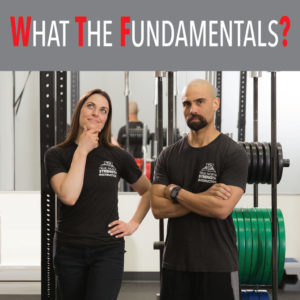What’s up, True Northers? Hopefully, you *wink-wink* after checking out the latest entry in our What the Fundamentals (aka WTF) series. It’s been a minute since our last WTF post so we wanted to remind you, the goal of this series is to reverse engineer the “cool”, “rad”, or “sexy” exercises you see and demonstrate how by focusing on the fundamentals you’re actually building the basics required to make all your exercise dreams come true.
In today’s entry, we’ll be reverse engineering one of our all-time favorite exercises, the chin up. The chin up is a pulling exercise, more specifically, a “vertical” pull (where you’re pulling from overhead), and requires you to be able to lift your own bodyweight which is not only super cool but super empowering.
There are lots of progressions to develop the necessary levels of strength, and stability to get over the bar; below we’re sharing one of our favorites with you.
Hand up if you remember like two seconds ago when we mentioned the chin up is a “vertical” pulling exercise, that hasn’t changed, but we should note there is another variation, the “horizontal” pull (where you’re pulling straight towards your chest). This is relevant as the vertical variation can be the more challenging of the two to learn, so we typically like to start folks with horizontal – it’s a great way to build the upper back strength necessary to work towards progressing to a chin up. Typically we like to see someone able to complete multiple sets of about 10 to 15 repetitions of a horizontal variation prior to progressing to vertical pulling or even working them simultaneously with a chin up progression.
Side note: If you need help with this, you can check out our WTF: TRX Inverted Row here.
Now, on to the…

A lot of people think about the chin-up as an upper-body exercise, they’re not wrong, but in order to get the most out of it the entire body needs to work together, and the FAH is a good place to start practicing this.
To begin, grip the bar shoulder-width apart with your palms facing inward towards your face. A strong grip is important as it sends a message to your shoulders to lock in stability making the movement more engaged. Next up, activate your core and squeeze your glutes as if you’re about to do a front plank – keeping your trunk engaged will make it easier to pull your body up as one unit. Jump up, chin over the top of the bar, eyes forward, chest open, shoulders back not rounding over the bar, elbows even with the body, not past or further back, and hold the position.
Aim for 2 to 3 sets of 20 to 30-seconds. If you are unable to hold yourself up with good form for a full 30 seconds, start with a 10-second hold, rest 10-20 seconds, and repeat for a total of 30 seconds, that would be one set, do that for a total of 2 to 3 sets, gradually limiting the amount of rest in-between and building up to a full 20-30-second hold per repetition.

This progression allows us to take advantage of the fact the body is stronger eccentrically, lowering yourself from the chin-up bar, versus concentrically, pulling yourself over the chin-up bar. Eccentric or negative chin-ups are a great exercise for improving upper body strength, more specifically the muscles of the mid to upper back along with the shoulders, arms, and core, basically everything you’ll need for a chin-up.
To start, activate your core and squeeze your glutes (remember your front plank), then pop yourself and begin to lower yourself in a controlled manner (read: slowly) until your arms are fully extended, not letting your elbows flare away from your body.
Aim for 2 to 3 sets of 5 to 6 repetitions, with the goal of a 5-second lower. If you find yourself popping and dropping after a couple of repetitions try resting for 10-20 seconds between each. If it’s still happening, start with the number of repetitions you’re able to complete with control and gradually add repetitions until you’re at 5 to 6 or even 8.

You can do a Flexed Arm Hang, have started working Eccentric Chin Ups into your training program but are still unable to get yourself over the bar, enter the Band-Assisted Chin Up. Bands offer more or less support depending on the size and thickness which means you can pick a band to meet you where you’re at.
Once you’ve picked your band, place your foot in, activate your core and squeeze your glutes (we’re starting to sound like a broken record, aren’t we?) and step off the box or bench, lowering yourself into full extension, think of the end position of your Eccentric Chin Ups. Remember, in this position we’re staying actively engaged through our lats meaning there is still some stiffness and tension before we start the movement rather than starting from a “dead hang” or fully relaxed position.
Aim for 2 to 3 sets of 6 to 8 repetitions. Once you’re able to complete 8 repetitions for multiple sets with one band, size down, and start the process again, beginning with 3 to 6 repetitions working up to 6 to 8.

You’ve been practicing your progressions 2 to 3 times per week and are feeling ready to try for your first chin-up. Yay! Let’s review everything we’ve learned thus far and give it a go.
Grip the bar shoulder-width apart with your palms facing inwards towards your face, remember a strong grip sends a message to your shoulders to lock in stability making the movement more engaged. Fire up that front plank, activating your core and squeezing your glutes this will help to create tension in your body resulting in less swing and an easier path to the bar. Think of trying to lift a rigid object versus a weighted limp and floppy object, the rigid is easier. Start in the down position staying actively engaged through the lats so there is some stiffness and tension before starting. Pull yourself up finishing with your chin over the bar, eyes forward, chest open, shoulders back, elbows even with the body – not past or further back, and repeat.
Aim for 2 to 3 sets of as many repetitions as pretty (AMRAP) gradually building repetitions over time, and there you have it, you can now do a chin up [insert happy dance here].
Before we sign off, a few things to note. Firstly, we mentioned, in the beginning, there are lots of progressions to get you over the bar, this is only one. So, if you’re struggling reach out to ask for help in finding the right progression for you. Second, if chin-ups are your goal, you need to be training some version of them at least 2 to 3 times per week, time and consistency are the chin-ups’ best friend.
Until next time, we’ll see you at the bar!


